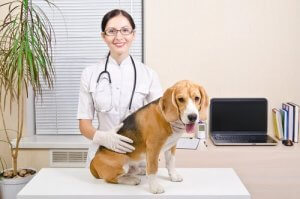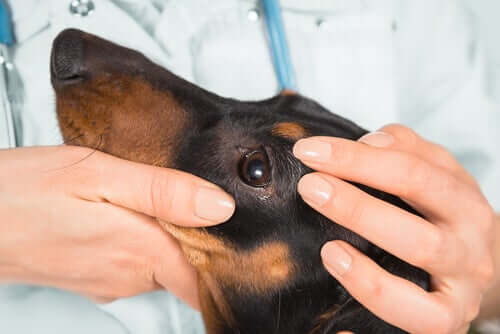Caring for Your Pets After Surgery


Written and verified by the lawyer Francisco María García
Unfortunately, for a number of reasons, pets sometimes require surgery, and it’s logical for their owners to worry. After surgery, it’s crucial for owners to know how to tend to their post-operative pets. That way, they can assure their animals will get all the care they need in order to recover.
The most common reasons why pets need surgery
Below are some of the most common reasons that can lead a pet to require surgical intervention:
- Neutering/spaying. Many people decide to neuter or spay their pets for health and safety reasons. Of course, birth control and keeping animals from ending up on the street or in shelters are other valid reasons.
- Obstructions in the digestive tract. This is one of the most common reasons for surgery. Some mischievous cats and dogs have a bad habit of eating everything they come across. When that’s the case, objects like balls and toys can cause bowel obstructions.
- Otohematoma. This refers to an accumulation of blood in a dog’s ear. Otohematomas occur as the result of dogs scratching excessively or bumping their heads.
- Fractures. Dogs and cats can break a bone as the result of a fall or during an outing where they can have accidents. It’s your responsibility as the owner to provide all the care your pet needs after surgery.

- Cataracts. Cataracts are a visual problem that usually occurs during old age. Surgery helps to restore or improve an animal’s sight.
Preoperative care for pets
If your pet’s already scheduled for surgery, then, as the owner, you need to prepare your animals in the following ways:
- Brush your pet’s hair to eliminate knots. This makes medical examination easier and prevents painful knotting.
- Protect your animals from catching any virus or bacteria. Avoid any contact between your pet and others during the days approaching the operation.
- Set up a space in your home where your pet can recover after surgery. This area needs to be clean to keep your pet safe from possible infection.
The best care for your pet after surgery
As soon as the vet considers your pet to be ready to go home, owners should follow certain recommendations. During the first hours, your pet’s likely to feel a little groggy as a result of the anesthesia. Then, little by little, the animal will manage to coordinate its movements.
- Space. Pets need to rest in order to recover. Therefore, you should keep your animals as far as possible from old noises and any other stimuli. If you have children in your home, then make sure they aren’t in contact with your healing pet.
- The first 24 hours. Some of the side effects of anesthesia are nausea and vomiting. In order to keep this from happening, you should only give your pet water during the first 24 hours after surgery. Another option is to offer your pet low-fat broth.
- Nutrition. More than likely, your pet will have a decreased appetite after surgery which will slowly increase. So, it’s best to start with a bland diet. At the pets store, you can find special foods that your animal can eat during post-operative recovery.

Medication, hygiene, and physical exercise
- Medication. Your pet may need to take antibiotics, pain killers, or anti-inflammatory medication after surgery. The veterinarian will determine the right course of treatment and proper diagnosis.
- Protecting the wound. Your pet will want to lick its wound constantly, but it’s very important to prevent this from happening. Not only can it lead to infection, but it can also remove stitches, cause fever, and lead to other complications.
- To keep your pet from licking its wounds, you should use an E-collar. This is a cone that goes around a pet’s neck and makes it impossible for the animal to lick its wounds. This is your best ally after your pet has surgery.
- Cleansing the wound. Your pet’s wound not only needs to stay clean, but also dry. In general, you’ll need to cleanse the wound at least twice a day. This involves using sterile gauze and a special antiseptic solution for this purpose. In any case, it’s best to follow your veterinarian’s instructions.
- Suture. The suture stitches come out 8 to 10 days after surgery. You should never attempt to remove them yourself–leave it up to your veterinarian.
- Physical activity. Animals that have recently had surgery shouldn’t perform sudden movements. However, gradually, you can reintroduce physical exercise into your pet’s routine. However, until the wound heals completely, your pet needs to stay indoors.
Unfortunately, for a number of reasons, pets sometimes require surgery, and it’s logical for their owners to worry. After surgery, it’s crucial for owners to know how to tend to their post-operative pets. That way, they can assure their animals will get all the care they need in order to recover.
The most common reasons why pets need surgery
Below are some of the most common reasons that can lead a pet to require surgical intervention:
- Neutering/spaying. Many people decide to neuter or spay their pets for health and safety reasons. Of course, birth control and keeping animals from ending up on the street or in shelters are other valid reasons.
- Obstructions in the digestive tract. This is one of the most common reasons for surgery. Some mischievous cats and dogs have a bad habit of eating everything they come across. When that’s the case, objects like balls and toys can cause bowel obstructions.
- Otohematoma. This refers to an accumulation of blood in a dog’s ear. Otohematomas occur as the result of dogs scratching excessively or bumping their heads.
- Fractures. Dogs and cats can break a bone as the result of a fall or during an outing where they can have accidents. It’s your responsibility as the owner to provide all the care your pet needs after surgery.

- Cataracts. Cataracts are a visual problem that usually occurs during old age. Surgery helps to restore or improve an animal’s sight.
Preoperative care for pets
If your pet’s already scheduled for surgery, then, as the owner, you need to prepare your animals in the following ways:
- Brush your pet’s hair to eliminate knots. This makes medical examination easier and prevents painful knotting.
- Protect your animals from catching any virus or bacteria. Avoid any contact between your pet and others during the days approaching the operation.
- Set up a space in your home where your pet can recover after surgery. This area needs to be clean to keep your pet safe from possible infection.
The best care for your pet after surgery
As soon as the vet considers your pet to be ready to go home, owners should follow certain recommendations. During the first hours, your pet’s likely to feel a little groggy as a result of the anesthesia. Then, little by little, the animal will manage to coordinate its movements.
- Space. Pets need to rest in order to recover. Therefore, you should keep your animals as far as possible from old noises and any other stimuli. If you have children in your home, then make sure they aren’t in contact with your healing pet.
- The first 24 hours. Some of the side effects of anesthesia are nausea and vomiting. In order to keep this from happening, you should only give your pet water during the first 24 hours after surgery. Another option is to offer your pet low-fat broth.
- Nutrition. More than likely, your pet will have a decreased appetite after surgery which will slowly increase. So, it’s best to start with a bland diet. At the pets store, you can find special foods that your animal can eat during post-operative recovery.

Medication, hygiene, and physical exercise
- Medication. Your pet may need to take antibiotics, pain killers, or anti-inflammatory medication after surgery. The veterinarian will determine the right course of treatment and proper diagnosis.
- Protecting the wound. Your pet will want to lick its wound constantly, but it’s very important to prevent this from happening. Not only can it lead to infection, but it can also remove stitches, cause fever, and lead to other complications.
- To keep your pet from licking its wounds, you should use an E-collar. This is a cone that goes around a pet’s neck and makes it impossible for the animal to lick its wounds. This is your best ally after your pet has surgery.
- Cleansing the wound. Your pet’s wound not only needs to stay clean, but also dry. In general, you’ll need to cleanse the wound at least twice a day. This involves using sterile gauze and a special antiseptic solution for this purpose. In any case, it’s best to follow your veterinarian’s instructions.
- Suture. The suture stitches come out 8 to 10 days after surgery. You should never attempt to remove them yourself–leave it up to your veterinarian.
- Physical activity. Animals that have recently had surgery shouldn’t perform sudden movements. However, gradually, you can reintroduce physical exercise into your pet’s routine. However, until the wound heals completely, your pet needs to stay indoors.
This text is provided for informational purposes only and does not replace consultation with a professional. If in doubt, consult your specialist.








